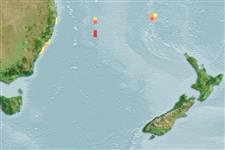Classification / Names
आम नाम | उपशब्द | Catalog of Fishes(वर्ग, प्रजाति) | ITIS | CoL | WoRMS | Cloffa
>
Eupercaria/misc (Various families in series Eupercaria) >
Labridae (Wrasses) > Xyrichtyinae
Etymology: Novaculops: Latin, novacula = razor + Greek, ops = appearance (Ref. 45335); pastellus: Name from Latin word referring to colors that are soft and subdued..
More on authors: Randall, Earle & Rocha.
Environment: milieu / climate zone / depth range / distribution range
पारिस्थितिकी
समुद्री प्रवाल-भित्ति संयुक्त; गहराई सीमा 10 - 25 m (Ref. 78585). Subtropical
Southwest Pacific: Australia.
आकार / वज़न / Age
Maturity: Lm ? range ? - ? cm
Max length : 11.7 cm SL पुल्लिंग / अलिंग; (Ref. 78585); 10.6 cm SL (female)
Life cycle and mating behavior
Maturities | पुनरुत्पत्ति | Spawnings | Egg(s) | Fecundities | लार्वा
Oviparous, distinct pairing during breeding (Ref. 205).
Randall, J.E., J.L. Earle and L.A. Rocha, 2008. Xyrichtys pastellus, a new razorfish from the southwest Pacific, with discussion of the related X. sciistius and X. woodi. aqua, Int. J. Ichthyol. 14(3):149-158. (Ref. 78585)
IUCN Red List Status (Ref. 130435)
Human uses
साधन
Special reports
Download XML
इंटरनेट स्रोत
Estimates based on models
Phylogenetic diversity index (Ref.
82804): PD
50 = 0.5156 [Uniqueness, from 0.5 = low to 2.0 = high].
Bayesian length-weight: a=0.01023 (0.00397 - 0.02640), b=3.06 (2.84 - 3.28), in cm total length, based on LWR estimates for this (Sub)family-body shape (Ref.
93245).
Trophic level (Ref.
69278): 3.4 ±0.4 se; based on size and trophs of closest relatives
लौटाव (Ref.
120179): ऊंचा, न्यूनतम जनसंख्या दुगनी समय अवलागत 15 महीने। (Preliminary K or Fecundity.).
Fishing Vulnerability (Ref.
59153): Low vulnerability (10 of 100).
